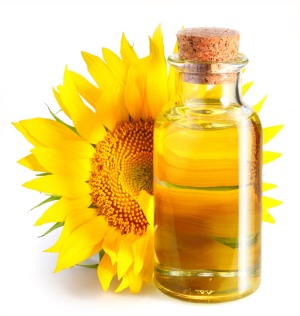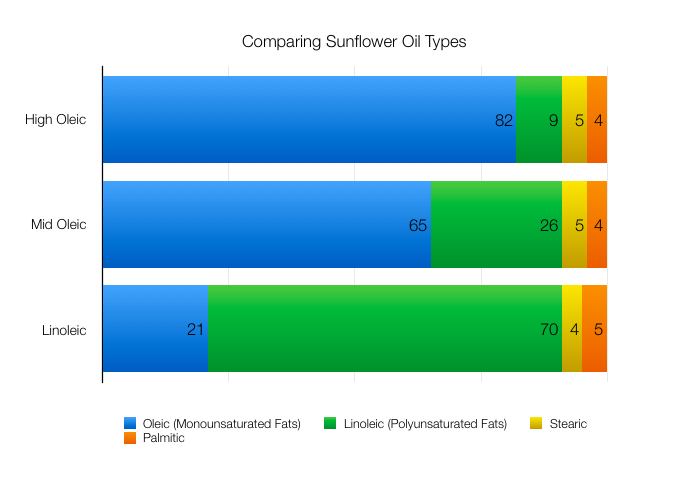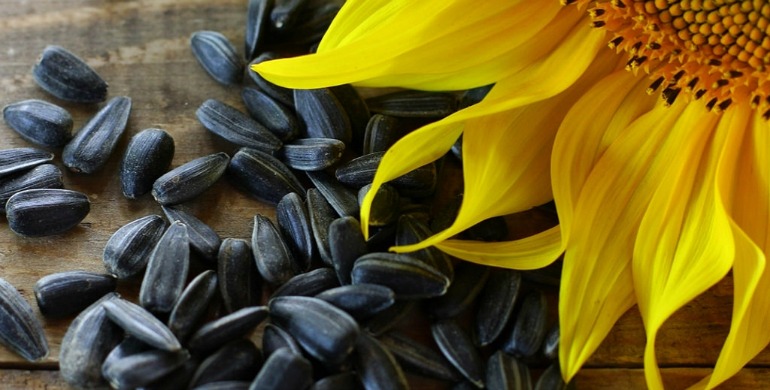Sunflower oil: is it healthy or unhealthy? Is it good or bad?

Because the ins-and-outs of the specific kind of fat make up and how an oil is made, this discussion can be confusing. To make the discussion even less straight forward, the sunflower oil that used to be common decades ago is becoming less and less prevalent, so we’re not always talking about the same thing when we say “sunflower oil”.
With the healthy food movement, high oleic expeller pressed sunflower oil is becoming more and more common and is beginning to dominate the US sunflower market.
On the whole, is sunflower oil good or bad? And is it actually a good fit for the food that you’re making? Today we’ll review what this oil is good for (or not) and the science behind it.
The Characteristics Of Sunflower Oil
Sunflower oil is a mild, unobtrusive oil that has a high heat tolerance and very little flavor. It’s often used for frying and sautéing because it doesn’t impart it’s own flavor into foods. It’s more often used for it’s functionality.
In general, this oil has:
- Light yellow, almost clear color
- Very little flavor profile and a mile aroma
- High smoke point and good heat tolerance
- High oleic versions are stable with long fry and shelf life
So why wouldn’t someone want to use sunflower oil? And if some people are saying it’s bad, why is that?
It has to do with the different types of sunflower oil available: some are good and some are bad. It also has to do with the sunflower oil that people remember being common 10 or 20 years ago vs. what is taking over the market today. Lastly, as one kind of “vegetable oil” it can get confused with some of the downsides of other vegetable oils.
So today is the day to clear that all up. We will go through the details and explain whether sunflower is good or bad — or at least point you to the healthiest version of sunflower oil available.
It’s Doesn’t Contain High Trans Fats
Trans fats are something that a lot of people discuss when they talk about vegetable oils in general. Seed oils, they say, including sunflower oil, are modified to be solid at room temperature and therefore contain trans fats.
There’s a few truths and a few myths related to sunflower in here. It IS true that vegetable oils like canola and soybean oil used to be partially hydrogenated to be solid at room temperature. This process has been used for decades as a replacement for butter (aka, this is what margarine is).
However, this argument actually has nothing to do with liquid sunflower oil. Even though it is a seed oil it, that doesn’t make it a partially hydrogenated seed oil… unless it is solid, like butter.
Sunflower oil is naturally found as a liquid, and it doesn’t contain the high level of trans fats that are created through the partial hydrogenation process.
While we’re discussing this topic, here’s bit more background on the updated status of partially hydrogenated oils (PHOs) in general…
In recent years these PHOs have been looked at more closely by scientists and legislation alike. In fact, as of July 2018, PHOs are no longer considered “GRAS” by the FDA GRAS is a term that means Generally Recognized As Safe. That’s right, partially hydrogenated oils are no longer considered safe to eat by US government starting in July of 2018. Companies have been working for months now to reformulate products so that they no longer contain these partially hydrogenated oils.
Let’s be clear on this front — stay away from PHOs at all costs, please! The partial hydrogenation process leaves unstable molecules which is what creates trans fats. A fully hydrogenated oil is different and is much more stable. These oils don’t contain trans fats, and you’re going to see them more and more in the years to come.
All of that said, sunflower oil is naturally found as a liquid oil, and wasn’t often sold in a solid partially hydrogenated form over the years. If you stick to the liquid version of this oil, it won’t contain the high levels trans fats in the same way that a PHO soybean oil or PHO canola oil would. But even those PHO options are going by the wayside now!
Monounsaturated & Polyunsaturated Fat Levels
Other arguments against sunflower oil have to do with the higher levels of polyunsaturated fat vs. monounsaturated fat. If you want to learn more about these type of fats, I’d recommend swapping over to read these two articles first:
Comparing Types Of Fat: Monounsaturated Polyunsaturated Saturated & Trans
Monounsaturated Vs. Polyunsaturated Vs. Saturated Fat: What Are They?
Omega 3, 6 & 9: What They Are And How They Add Up
As humans, we need both types of fat: mono and poly. Polyunsaturated fat used to be hailed in the 70s as the healthy fat. That said, science has developed quite a bit since then and they are learning that monounsaturated fats are actually the “healthy-for-you” fats.
We do need some level of polyunsaturated fats, but it’s not very high. We need a much higher level of monounsaturated fats, as these are the type of fats that protect rather than oxidize once they’re in your body.
The reality of sunflower oil is that there are different grades, each with a different level of polyunsaturated vs. monounsaturated oil. The grades are:
Mid-Oleic Sunflower Oil (sometimes called NuSun)
Linoleic Sunflower Oil or Classic Sunflower Oil
High oleic oils are considered the most healthy, and have the most monosaturated fat that makes up the oil. Linoleic is comprised of more polyunsaturated fats (considered a less healthy fat) and mid oleic falls somewhere in between.

Linoleic Sunflower Oil
Traditional sunflower oils have fallen into two categories, one high in oleic acid and the other high in linoleic acid. Linoleic acid is one of the essential fatty acids in the human diet, and linoleic varieties of sunflower oil contain nearly 70 percent polyunsaturated linoleic acid. Another 20 percent is in monounsaturated oleic acid, and the remaining 10 to 11 percent is saturated fat.
High Oleic Sunflower Oil
High oleic sunflower oil is radically different in its makeup. It consists primarily of monounsaturated oleic acids, at around 80 percent of the total. Saturated fats and polyunsaturated linoleic acid make up the balance, in equal proportions.
Bulk high oleic sunflower oil is important in the manufacture of food products, because it remains stable without hydrogenation and will not go rancid in storage.
High oleic sunflower oil actually has higher monounsaturated fat levels than olive oil — and olive oil is known for containing this healthy fat!
Mid-Oleic Sunflower Oil
Mid-oleic sunflower oil takes a middle position between the two traditional oils, with monounsaturated oleic acid accounting for roughly two-thirds of the fat content, polyunsaturated linoleic acid at roughly 25 percent, and about 9 percent saturated fat.
As more growers begin to move to high oleic sunflower oil, this oil is in limited supply in recent years.
What Kind Of Sunflower Oil Should You Choose?
You want a sunflower oil that is lower in polyunsaturated fats and higher in monounsaturated fats. Therefore, I’d point you to a high oleic sunflower oil as the healthiest sunflower oil available.
Now that we’ve come to that conclusion, this will bring us to the next argument around sunflower oil: it is solvent expelled or expeller pressed?
Solvent Expelled or Expeller Pressed
All sunflower oils can be solvent expelled or expeller pressed — this is merely a description of how the oil is pulled out of the seeds. Solvent expelled oils use a chemical like hexane to pull the oil out of the seed. Expeller pressed oils physically squeeze the oil out of the seed without using chemicals to extract it.
Most linoleic or classic sunflower oils use solvent expelling — this is just a matter of the price demand on this oil. Most people buying classic sunflower oil are looking for a lower cost, and solvent expelling goes with that.
On the other hand, a lot of the high oleic (healthier) sunflower oil on the market is expelled using an expeller press. That said, it still can be solvent expelled so it’s important to look for the description “expeller pressed” if you want it.
Sunflower Oil Is Refined
Sunflower oils are refined — no matter which grade you choose.
This refining process is typically called “RBD” in the bulk world. RBD stands for Refined, Bleached & Deodorized. These terms represent how the oil was processed after being produced. It means that the oil went through a refining process, which strips a lot of the natural color and flavor from the oil.
The exact refining process is different for each type of oil, though there are some components that look very similar.
For the most part, it is typically a high heat process, which uses heat or steam. They also typically use an earthen bleaching clay to pull any pigment out of the oil. Lastly, the process will often involve filtering, or sometimes double filtering the final product.
The end result is a light colored, neutral flavored, almost-clear oil. This refining process is also used with many different oils: for example canola, soybean, coconut and grapeseed oil along with pure olive oil, extra light olive oil and many more.
The only oils that are not refined in this way are Extra Virgin Olive Oil, Organic Virgin Coconut Oil and those oils that state “unrefined” clearly on the label.
In Conclusion: Is Sunflower Oil Good or Bad?
Like many discussions in life, it can be both good and bad depending on which option you choose. Classic sunflower oil (or linoleic sunflower oil) has higher levels of polyunsaturated fats which you shouldn’t eat in excess. They’re also often solvent expelled. If anything used to be partially hydrogenated for sunflower oil, this grade was it. So no, classic sunflower oil really isn’t very healthy.
High oleic expeller pressed sunflower oil is a different story, however. It has higher monounsaturated fat levels than olive oil does, and is expeller pressed — aka, it doesn’t use a chemical solvent. This one is actually rather healthy for you in comparison to other options.
Now, if you asked me if I would rather eat Expeller Pressed High Oleic Sunflower Oil vs. Extra Virgin Olive Oil in my home kitchen, I would still say Extra Virgin Olive Oil — personal preference, but it’s a close call.
What would I want my chips to be fried in? Expeller Pressed High Oleic Sunflower (or Safflower) Oil, hands down.
Manufacturing Advice Related To Sunflower Oil
Many manufacturers today in the natural food industry use high oleic expeller pressed sunflower oil and high oleic expeller pressed safflower oil interchangeably. These two oils have very similar taste and functionality, and of course are both high oleic and expeller pressed.
Many chip companies today use an “and/or” statement on their ingredient label, which allows them a bit more flexibility and risk management in their supply chain to use both of these options interchangeably.
If you want to learn more about why this is an ideal choice to make for your company, we recommend reading more in the article below: Why It's Ideal To List Multiple Interchangeable Bulk Oil Ingredients
Topics: Sunflower/Safflower Oil












